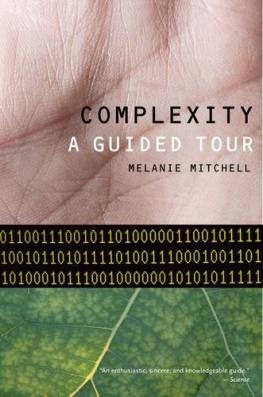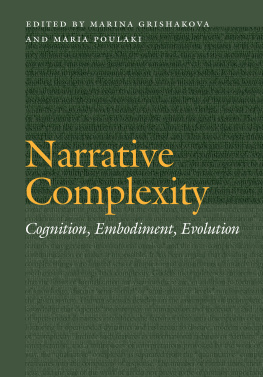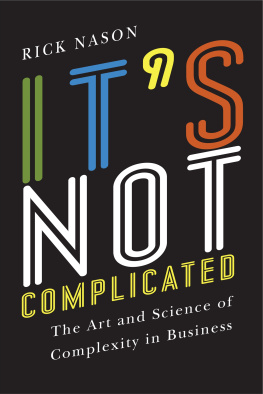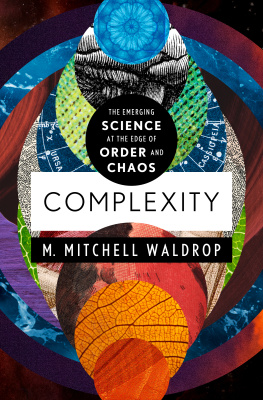Complexity
Complexity
A Guided Tour
MELANIE MITCHELL


Oxford University Press, Inc., publishes works that further
Oxford Universitys objective of excellence
in research, scholarship, and education.
Oxford New York
Auckland Cape Town Dar es Salaam Hong Kong Karachi
Kuala Lumpur Madrid Melbourne Mexico City Nairobi
New Delhi Shanghai Taipei Toronto
With offices in
Argentina Austria Brazil Chile Czech Republic France Greece
Guatemala Hungary Italy Japan Poland Portugal Singapore
South Korea Switzerland Thailand Turkey Ukraine Vietnam
Copyright 2009 by Melanie Mitchell
The author is grateful to the following publishers for permission to reprint excerpts from the following works that appear as epigraphs in the book. Gdel, Escher, Bach: an Eternal Braid by Douglas R. Hofstadter, copyright 1979 by Basic Books and reprinted by permission of the publisher. The Dreams of Reason by Heinz Pagels, copyright by Heinz Pagels and reprinted by permission of Simon & Schuster Adult Publishing Group. Arcadia by Tom Stoppard, copyright 1993 by Tom Stoppard and reprinted with permission of Faber and Faber, Inc., an affiliate of Farrar, Strauss & Giroux, LLC. Trading Cities from Invisible Cities by Italo Calvino, published by Secker and Warburg and reprinted by permission of The Random House Group Ltd. The Ages of Gaia: A Biography of Our Living Earth by James Lovelock, copyright 1988 by The Commonwealth Fund Book Program of Memorial Sloan-Kettering Cancer Center and used by permission of W. W. Norton & Company, Inc. Mine the Harvest: A Collection of New Poems by Edna St. Vincent Millay, copyright 1954, 1982 by Norma Millay Ellis and reprinted by permission of Elizabeth Barnett, Literary Executor, the Millay Society. Trading Cities from Invisible Cities by Italo Calvino, copyright 1972 by Giulio Einaudi editore s.p.a., English translation by William Weaver, copyright 1974 by Houghton Mifflin Harcourt Publishing Company, and reprinted by permission of the publisher. Complexity: Life at the Edge of Chaos by Roger Lewin, copyright 1992, 1999 by Roger Lewin and reprinted by permission of the author.
Published by Oxford University Press, Inc.
198 Madison Avenue, New York, New York 10016
www.oup.com
Oxford is a registered trademark of Oxford University Press
All rights reserved. No part of this publication may be reproduced, stored in a retrieval system, or transmitted, in any form or by any means, electronic, mechanical, photocopying, recording, or otherwise, without the prior permission of Oxford University Press.
Library of Congress Cataloging-in-Publication Data
Mitchell, Melanie.
Complexity: a guided tour/Melanie Mitchell.
p. cm.
Includes bibliographical references and index.
ISBN 978-0-19-512441-5
1. Complexity (Philosophy) I. Title.
Q175.32.C65M58 2009
501dc22 2008023794
9 8 7 6 5 4 3 2 1
Printed in the United States of America
on acid-free paper
To Douglas Hofstadter and John Holland
CONTENTS
PREFACE
the most natural thing in the world to grasp. Its simply the belief that a whole can be understood completely if you understand its parts, and the nature of their sum. No one in her left brain could reject reductionism.
Douglas Hofstadter, Gdel, Escher, Bach: an Eternal Golden Braid
REDUCTIONISM HAS BEEN THE DOMINANT approach to science since the 1600s. Ren Descartes, one of reductionisms earliest proponents, described his own scientific method thus:
Since the time of Descartes, Newton, and other founders of the modern scientific method until the beginning of the twentieth century, a chief goal of science has been a reductionist explanation of all phenomena in terms of fundamental physics. Many late nineteenth-century scientists agreed with the well-known words of physicist Albert Michelson, who proclaimed in 1894 that have been firmly established and that further advances are to be sought chiefly in the rigorous application of these principles to all phenomena which come under our notice.
Of course within the next thirty years, physics would be revolutionized by the discoveries of relativity and quantum mechanics. But twentieth-century science was also marked by the demise of the reductionist dream. In spite of its great successes explaining the very large and very small, fundamental physics, and more generally, scientific reductionism, have been notably mute in explaining the complex phenomena closest to our human-scale concerns.
Many phenomena have stymied the reductionist program: the seemingly irreducible unpredictability of weather and climate; the intricacies and adaptive nature of living organisms and the diseases that threaten them; the economic, political, and cultural behavior of societies; the growth and effects of modern technology and communications networks; and the nature of intelligence and the prospect for creating it in computers. The antireductionist catch-phrase, the whole is more than the sum of its parts, takes on increasing significance as new sciences such as chaos, systems biology, evolutionary economics, and network theory move beyond reductionism to explain how complex behavior can arise from large collections of simpler components.
By the mid-twentieth century, many scientists realized that such phenomena cannot be pigeonholed into any single discipline but require an interdisciplinary understanding based on scientific foundations that have not yet been invented. Several attempts at building those foundations include (among others) the fields of cybernetics, synergetics, systems science, and, more recently, the science of complex systems.
In 1984, a diverse interdisciplinary group of twenty-four prominent scientists and mathematicians met in the high desert of Santa Fe, New Mexico, to discuss these which can be properly studied only in an interdisciplinary environment and promote a unity of knowledge and a recognition of shared responsibility that will stand in sharp contrast to the present growing polarization of intellectual cultures. Thus the Santa Fe Institute was created as a center for the study of complex systems.
In 1984 I had not yet heard the term complex systems, though these kinds of ideas were already in my head. I was a first-year graduate student in Computer Science at the University of Michigan, where I had come to study artificial intelligence; that is, how to make computers think like people. One of my motivations was, in fact, to understand how people thinkhow abstract reasoning, emotions, creativity, and even consciousness emerge from trillions of tiny brain cells and their electrical and chemical communications. Having been deeply enamored of physics and reductionist goals, I was going through my own antireductionist epiphany, realizing that not only did current-day physics have little, if anything, to say on the subject of intelligence but that even neuroscience, which actually focused on those brain cells, had very little understanding of how thinking arises from brain activity. It was becoming clear that the reductionist approach to cognition was misguidedwe just couldnt understand it at the level of individual neurons, synapses, and the like.
Therefore, although I didnt yet know what to call it, the program of complex systems resonated strongly with me. I also felt that my own field of study, computer science, had something unique to offer. Influenced by the early pioneers of computation, I felt that
Next page











